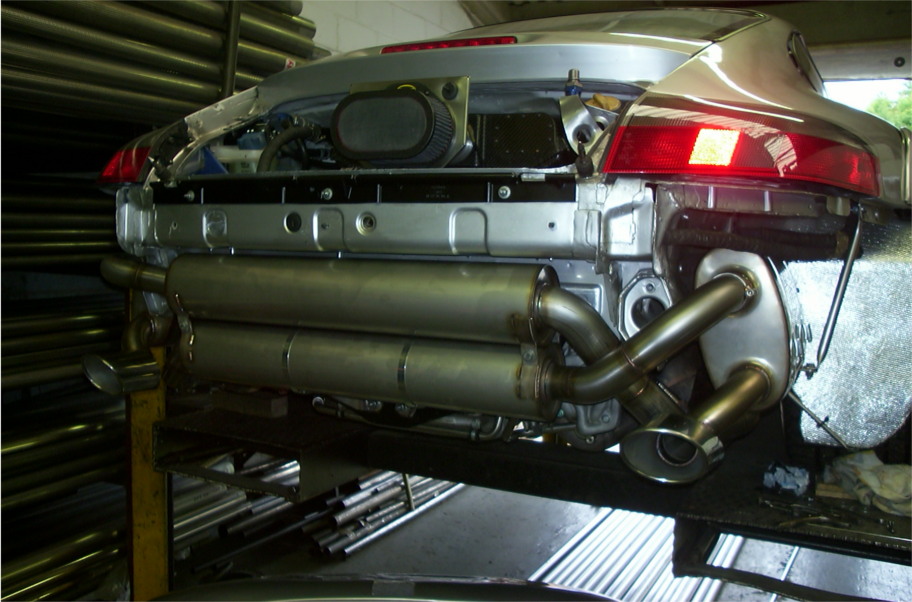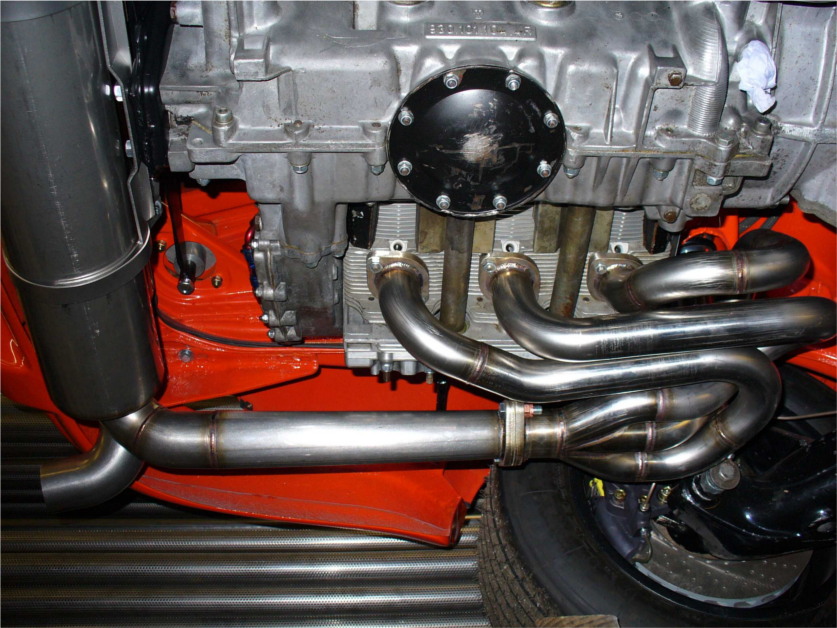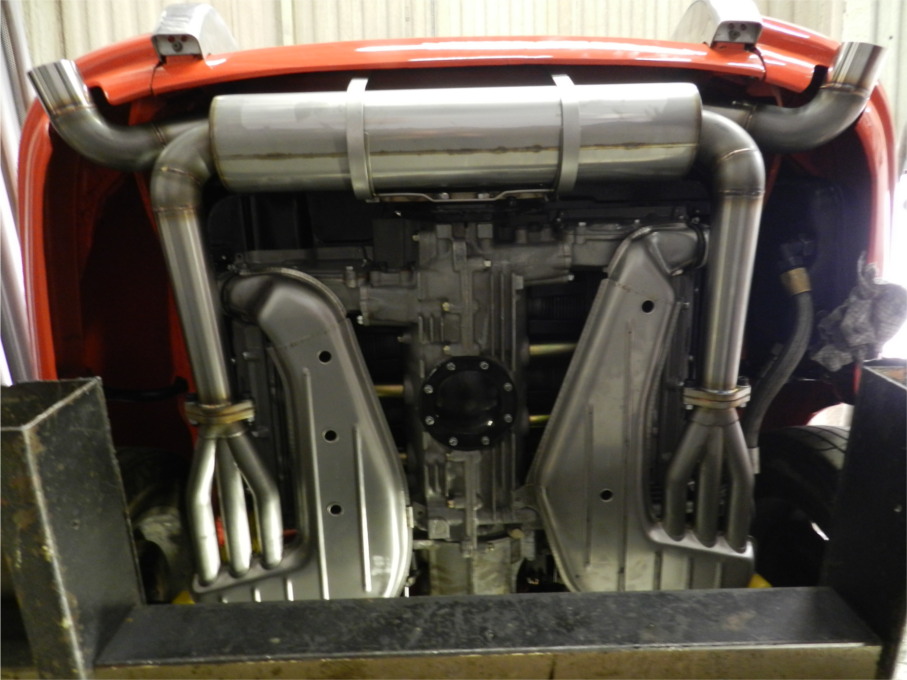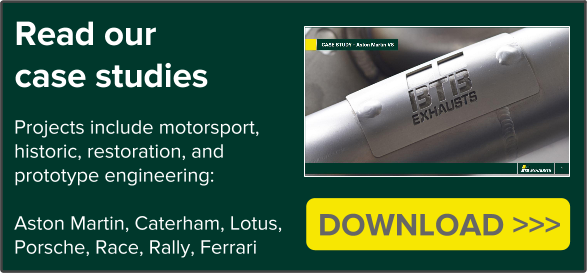-
Porsche 911 silencers

One of the most persistent problems faced by any enthusiastic 911 owner who wishes
to compete in their car is noise. Whatever variant they decide to use, the rear engine
layout always determines that because of the extreme packaging constraints and the
proximity of other noisy components the sound level measured from the exhaust
tailpipe exceeds that of other sportscars. Add to this the desire that most competing
drivers have to try and improve the performance of their car by increasing power
and/or reducing weight and you have an idea of the scale of the difficulties faced by
an exhaust designer.
Early cars:
All 911’s up to the introduction of the 993 have essentially the same limited amount
of space available for silencers. This led the original designers to come up with the
banana shaped silencer that fits between the rear of the engine and the rear
bumper.
The impact bumper cars introduced around 1974 still used this as the main silencing
element, with the addition of a small pre silencer alongside the engine. If a fibreglass
replica of the rear bumper is used as per the 911SCRS race and rally cars, there is a
bit more space available behind the engine for larger silencers. At the time the SCRS
was competing noise was not really an issue and the most efficient design of twin
tapered megaphones that ran straight from the end of each 3 into 1 manifold to exit
just clear of the bumper were only nominally muffled with tiny oval cans. Today if
this independent configuration is desired for maximum power, it is necessary to fit
twin transverse round silencers on top of each other, with the left hand bank of
cylinders exiting through a tailpipe on the right and side and vice versa. Linking both
cylinder banks together via a 2 into 1 pipe can be desirable for torque on smaller
capacity engined rally cars, but the complicated routing required of this pipe
inevitably will compromise the space left for a silencer, which is why the two
functions were combined within the OE silencer. The standard OE silencer remains a
good compromise between power and noise, but its single tailpipe design will
compromise the power of the highest output engines that can now be fitted to these
early body cars. Pattern copies of this silencer exist but should be avoided because
they often feature power sapping internal baffling arrangements that cannot be seen
from outside and often are not as efficient at attenuating the unique flat six noise
frequencies.
The 964 body affords a little more scope for more silencing with a combination of
simpler shapes of oval and round boxes, but inevitably the power output potential,
pipe sizes and hence noise volume increases in line with the arrival of 3.4 and 3.6 litre
engines so the same challenges largely apply.
993:
The more emphatically rounded rear end styling of this model freed up considerably
more space in the rear arches just behind the rear wheels, which allows fitment of
symmetrical oval reverse flow silencers each side. Although road noise levels
dictated the use of somewhat restrictive internals to the OE system, at last the scope
exists for a free flowing system to be designed that uses the extra volume, and pipe
length available to give a useful increase in power without producing an unacceptable
increase in tailpipe
noise.

If this power is to be regularly exploited in competition or trackday, it is
recommended that the silencers are only made from the highest grade stainless steels
and preferably are of a repackable design to enable the noise attenuating material
within the silencer to be replaced without the cost of replacing the entire system. This
is because of the higher exhaust gas temperatures resulting from the more extreme
ignition timing and leaner fuel mixtures made possible by
much more precise electronic engine control systems. Initially when the 993 was
raced in the UK they ran with the boot lid/spoiler propped open, which meant that the
noise from the air-cooled engine (and amplified by the fan) was directed in the same
direction as the tailpipes, i.e. straight at the scrutineers noise meter. However, when
the RS biplane spoilers were fitted the engine noise was directed upwards away from
the exhausts, which meant that the efficient straight through systems were still viable.
996:
The 996 and onwards are fully water-cooled of course, which means and end to the
noisy engine mounted fan, and more sound absorbing water channels in the engine
castings. 996’s also have yet more room behind the rear bodywork for mounting
silencers, which means that even fire-breathing race-tuned GT3RSR’s can be fitted
with enough silencers to comply with trackdays, without compromising their
awesome performance. For racing the emphasis is on ultimate performance and as
such the smallest silencers are fitted that only just comply with circuit noise limits, so
as to minimise the weight slung out behind the rear axle.

Silencing secrets:
The essential element to a performance system is the straight-through or absorption
type of silencer. This consists of a perforated duct surrounded by sound absorbing
material, which converts sound energy (vibration) into heat. This type of silencer
typically attenuates the high frequency noises from the engine leaving the
characteristic low bassy burble to emanate from the tailpipe. There are two problems
with this type of silencer when fitted to 911’s, firstly with the earlier smaller bodied
cars it is difficult to fit a silencer that contains enough volume of sound deadening
around a big enough perforated tube within the confines of the bodywork. Secondly,
the short pipe run on any rear engined car between the engine and silencers, doesn’t
allow for much dissipation of heat before the gasses encounter the duct. This can lead
to rapid deterioration of the sound deadening fibres which are then sucked into the
exhaust stream and blown out of the tailpipe. One of the tricks to reducing the noise
further is to combine the two cylinder banks, to allow a degree of noise cancellation to
take place. This is where the peak pressure wave from one cylinder is cancelled by its
opposing wave form being present in the same section of silencer. A mild version of
this can be effected by having a carefully positioned crossover or balance tube
between the two independent pipe runs from each cylinder bank. This minimises the
possibility of reversion waves being reflected into the cylinder head during valve
overlap, which can have a detrimental effect on the incoming fuel air charge and
efficient cylinder filling. If more sound reduction is necessary both cylinder bank
exhaust flows can be arranged to directly face each other, preferably within a damped
chamber in the silencer. Turbocharged cars tend to produce lots of low frequency
noise, because the high frequencies are lost in the exhaust turbine, and they need
much larger ducts to cope with the hotter gas flows. However, they don’t suffer as
much from reflected waves as the incoming charge is pressurised above atmospheric
pressure, and the turbine interrupts the reversion pulses anyway. The lower
frequencies can only be attenuated in large well damped expansion chambers unless
restrictive baffling is used which will sap power by increasing back pressure in the
system preventing effective spool-up of the turbo.
Copyright Joe Ellis 18 December 2005
Follow BTB Exhausts on @BTBExhausts and LinkedIn or Subscribe to our newsletter.
Read more about our Motorsport Exhaust Systems or Download our Brochure.
- T +44 (0) 1327 261797
- E sales@btbexhausts.co.uk

